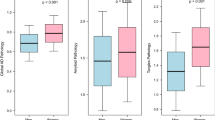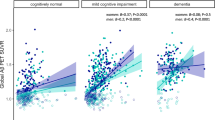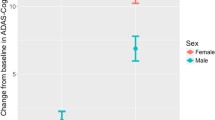Abstract
Women are disproportionately affected by Alzheimer’s disease (AD) in terms of both disease prevalence and severity. Previous autopsy work has suggested that, in the presence of AD neuropathology, females are more susceptible to the clinical manifestation of AD. This manuscript extends that work by evaluating whether sex alters the established associations between cerebrospinal fluid (CSF) biomarker levels and brain aging outcomes (hippocampal volume, cognition). Participants were drawn from the Alzheimer’s Disease Neuroimaging Initiative (ADNI) and included individuals with normal cognition (n = 348), mild cognitive impairment (n = 565), and AD (n = 185). We leveraged mixed effects regression models to assess the interaction between sex and baseline cerebrospinal fluid biomarker levels of amyloid-β42 (Aβ-42) and total tau on cross-sectional and longitudinal brain aging outcomes. We found a significant interaction between sex and Aβ-42 on longitudinal hippocampal atrophy (p = 0.002), and longitudinal decline in memory (p = 0.017) and executive function (p = 0.025). Similarly, we observed an interaction between sex and total tau level on longitudinal hippocampal atrophy (p = 0.008), and longitudinal decline in executive function (p = 0.034). Women with Aβ-42 and total tau levels indicative of worse pathological changes showed more rapid hippocampal atrophy and cognitive decline. The sex difference was particularly pronounced among individuals with MCI, with lower education, and varied by APOE ε4 allele. These results suggest females may be more susceptible to the clinical manifestation of AD.


Similar content being viewed by others
References
Alvarez-de-la-Roza, M., Silva, I., Nilsen, J., Perez, M., Garcia-Segura, L. M., Ávila, J., & Naftolin, F. (2005). Estradiol prevents neural tau hyperphosphorylation characteristic of Alzheimer’s disease. Annals of the New York Academy of Sciences, 1052(1), 210–224.
Anastasio, T. J. (2013). Exploring the contribution of estrogen to amyloid-beta regulation: a novel multifactorial computational modeling approach. Frontiers in Pharmacology, 4. doi:10.3389/fphar.2013.00016.
Apostolova, L. G., Dinov, I. D., Dutton, R. A., Hayashi, K. M., Toga, A. W., Cummings, J. L., & Thompson, P. M. (2006). 3D comparison of hippocampal atrophy in amnestic mild cognitive impairment and Alzheimer’s disease. Brain, 129(11), 2867–2873.
Barnes, L. L., Wilson, R. S., Bienias, J. L., Schneider, J. A., Evans, D. A., & Bennett, D. A. (2005). Sex differences in the clinical manifestations of Alzheimer disease pathology. Archives of General Psychiatry, 62(6), 685–691.
Crane, P. K., Carle, A., Gibbons, L. E., Insel, P., Mackin, R. S., Gross, A., et al. (2012). Development and assessment of a composite score for memory in the Alzheimer’s disease neuroimaging initiative (ADNI). Brain Imaging and Behavior, 6(4), 502–516.
Dale, A. M., Fischl, B., & Sereno, M. I. (1999). Cortical surface-based analysis: I. Segmentation and surface reconstruction. NeuroImage, 9(2), 179–194.
Desikan, R. S., Segonne, F., Fischl, B., Quinn, B. T., Dickerson, B. C., Blacker, D., et al. (2006). An automated labeling system for subdividing the human cerebral cortex on MRI scans into gyral based regions of interest. NeuroImage, 31(3), 968–980.
Farrer, L. A., Cupples, L. A., Haines, J. L., Hyman, B., Kukull, W. A., Mayeux, R., et al. (1997). Effects of age, sex, and ethnicity on the association between apolipoprotein E genotype and Alzheimer disease: a meta-analysis. Jama, 278(16), 1349–1356.
Fischl, B., Sereno, M. I., Tootell, R. B. H., & Dale, A. M. (1999a). High-resolution intersubject averaging and a coordinate system for the cortical surface. Human Brain Mapping, 8(4), 272–284.
Fischl, B., Sereno, M. I., & Dale, A. M. (1999b). Cortical surface-based analysis: II: inflation, flattening, and a surface-based coordinate system. NeuroImage, 9(2), 195–207.
Gibbons, L. E., Carle, A. C., Mackin, R. S., Harvey, D., Mukherjee, S., Insel, P., et al. (2012). A composite score for executive functioning, validated in Alzheimer’s disease neuroimaging initiative (ADNI) participants with baseline mild cognitive impairment. Brain Imaging and Behavior, 6(4), 517–527.
Hebert, L. E., Weuve, J., Scherr, P. A., & Evans, D. A. (2013). Alzheimer disease in the United States (2010–2050) estimated using the 2010 census. Neurology, 80(19), 1778–1783.
Henderson, V. W., & Buckwalter, J. G. (1994). Cognitive deficits of men and women with Alzheimer’s disease. Neurology, 44(1), 90–90.
Hua, X., Hibar, D. P., Lee, S., Toga, A. W., Jack, C. R., Weiner, M. W., et al. (2010). Sex and age differences in atrophic rates: an ADNI study with n = 1368 MRI scans. Neurobiology of Aging, 31(8), 1463–1480.
Jack, C. R., Bernstein, M. A., Fox, N. C., Thompson, P., Alexander, G., Harvey, D., et al. (2008). The Alzheimer’s disease neuroimaging initiative (ADNI): MRI methods. Journal of Magnetic Resonance Imaging, 27(4), 685–691.
Jagust, W. J., Landau, S. M., Shaw, L. M., Trojanowski, J. Q., Koeppe, R. A., Reiman, E. M., et al. (2009). Relationships between biomarkers in aging and dementia. Neurology, 73(15), 1193–1199.
Launer, L., Andersen, K., Dewey, M., Letenneur, L., Ott, A., Amaducci, L., et al. (1999). Rates and risk factors for dementia and Alzheimer’s disease results from EURODEM pooled analyses. Neurology, 52(1), 78–78.
Lin, K. A., Choudhury, K. R., Rathakrishnan, B. G., Marks, D. M., Petrella, J. R., Doraiswamy, P. M., & Initiative, A. S. D. N. (2015). Marked gender differences in progression of mild cognitive impairment over 8 years. Alzheimer’s & Dementia: translational Research & Clinical Interventions, 1(2), 103–110.
Luine, V. N. (2014). Estradiol and cognitive function: past, present and future. Hormones and Behavior, 66(4), 602–618. doi:10.1016/j.yhbeh.2014.08.011.
Mormino, E. C., Kluth, J. T., Madison, C. M., Rabinovici, G. D., Baker, S. L., Miller, B. L., et al. (2009). Episodic memory loss is related to hippocampal-mediated beta-amyloid deposition in elderly subjects. Brain, 132(5), 1310–1323.
Nilsen, J., Chen, S., Irwin, R. W., Iwamoto, S., & Brinton, R. D. (2006). Estrogen protects neuronal cells from amyloid beta-induced apoptosis via regulation of mitochondrial proteins and function. BMC Neuroscience, 7(1), 74.
Pfeffer, R., Kurosaki, T., Harrah, C., Chance, J., & Filos, S. (1982). Measurement of functional activities in older adults in the community. Journal of Gerontology, 37(3), 323–329.
Reuter, M., Schmansky, N. J., Rosas, H. D., & Fischl, B. (2012). Within-subject template estimation for unbiased longitudinal image analysis. NeuroImage, 61(4), 1402–1418.
Sampedro, F., Vilaplana, E., de Leon, M. J., Alcolea, D., Pegueroles, J., Montal, V., et al. (2015). APOE-by-sex interactions on brain structure and metabolism in healthy elderly controls. Oncotarget, 6(29), 26663–26674. doi:10.18632/oncotarget.5185.
Shaw, L. M., Vanderstichele, H., Knapik-Czajka, M., Figurski, M., Coart, E., Blennow, K., et al. (2011). Qualification of the analytical and clinical performance of CSF biomarker analyses in ADNI. Acta Neuropathologica, 121(5), 597–609.
Tschanz, J. T., Corcoran, C. D., Schwartz, S., Treiber, K., Green, R. C., Norton, M. C., et al. (2011). Progression of cognitive, functional, and neuropsychiatric symptom domains in a population cohort with Alzheimer dementia: the cache county dementia progression study. The American Journal of Geriatric Psychiatry, 19(6), 532–542.
Acknowledgments
The authors report no conflicts of interest. Dr. Hohman had full access to all the data in the study and takes responsibility for the integrity of the data and the accuracy of the data analysis. This research was supported in part by the Building Interdisciplinary Research Careers in Women’s Health program (K12 HD043483), the Vanderbilt Medical Scientist Training Program (T32 GM07347), and the Vanderbilt Memory & Alzheimer’s Center.
Data collection and sharing for this project was funded by the Alzheimer’s Disease Neuroimaging Initiative (ADNI) (National Institutes of Health Grant U01 AG024904) and DOD ADNI (Department of Defense award number W81XWH-12-2-0012). ADNI is funded by the National Institute on Aging, the National Institute of Biomedical Imaging and Bioengineering, and through generous contributions from the following: Alzheimer’s Association; Alzheimer’s Drug Discovery Foundation; Araclon Biotech; BioClinica, Inc.; Biogen Idec Inc.; Bristol-Myers Squibb Company; Eisai Inc.; Elan Pharmaceuticals, Inc.; Eli Lilly and Company; EuroImmun; F. Hoffmann-La Roche Ltd. and its affiliated company Genentech, Inc.; Fujirebio; GE Healthcare; ; IXICO Ltd.; Janssen Alzheimer Immunotherapy Research & Development, LLC.; Johnson & Johnson Pharmaceutical Research & Development LLC.; Medpace, Inc.; Merck & Co., Inc.; Meso Scale Diagnostics, LLC.; NeuroRx Research; Neurotrack Technologies; Novartis Pharmaceuticals Corporation; Pfizer Inc.; Piramal Imaging; Servier; Synarc Inc.; and Takeda Pharmaceutical Company. The Canadian Institutes of Rev. December 5, 2013 Health Research is providing funds to support ADNI clinical sites in Canada. Private sector contributions are facilitated by the Foundation for the National Institutes of Health (www.fnih.org). The grantee organization is the Northern California Institute for Research and Education, and the study is coordinated by the Alzheimer’s Disease Cooperative Study at the University of California, San Diego. ADNI data are disseminated by the Laboratory for Neuro Imaging at the University of Southern California.
The funders had no role in study design, data collection and analysis, decision to publish, or preparation of the manuscript.
Author information
Authors and Affiliations
Consortia
Corresponding author
Ethics declarations
This research was supported in part by the Building Interdisciplinary Research Careers in Women’s Health program (K12 HD043483), the Vanderbilt Medical Scientist Training Program (T32 GM07347), and the Vanderbilt Memory & Alzheimer’s Center. The authors report no conflicts of interest. Informed consent was obtained from all participants included in the study.
Additional information
Data used in preparation of this article were obtained from the Alzheimer’s Disease Neuroimaging Initiative (ADNI) database (adni.loni.usc.edu). As such, the investigators within the ADNI contributed to the design and implementation of ADNI and/or provided data but did not participate in analysis or writing of this report. A complete listing of ADNI investigators can be found at: http://adni.loni.usc.edu/wp-content/uploads/how_to_apply/ADNI_Acknowledgement_List.pdf
Rights and permissions
About this article
Cite this article
Koran, M.E.I., Wagener, M., Hohman, T.J. et al. Sex differences in the association between AD biomarkers and cognitive decline. Brain Imaging and Behavior 11, 205–213 (2017). https://doi.org/10.1007/s11682-016-9523-8
Published:
Issue Date:
DOI: https://doi.org/10.1007/s11682-016-9523-8




